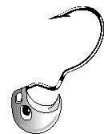 |
|
|
Click on the image to vote for this site. Want to join The Top 1000 Fishing Sites, click here! Want to view the list, click here!
|
Effective Backtrolling Tactics
There seems to be a move by walleye fishermen to buy bigger boats and
motors with console steering. To achieve good boat control with this type
of rig we use bow and transom-mount electrics in combination with
kicker motors. There are also a lot of great walleye anglers out
there who are running bigger boats and motors and are still sitting in
the back of the boat with a tiller handle. Which way is better?
It doesn't matter as long as you work hard and get good at controlling
the boat using the methods you are comfortable with. I prefer the On many bodies of water, walleye will relate to structure. They don't just hover around reefs, sunken islands and points, they hug that structure. These walleye will be tight to the bottom, laying in the dips between rocks and cuts in the bottom. They may be feeding, or more likely, they may be sitting there, moving only when an easy meal comes by. When fishing structure you have to be able to stay tight to the fish -- holding on bottom. Moving off, just a few feet, could put you outside the fish. The object is to use your depth finder to locate the structure, the best spots on that structure, and the fish that are holding there. Techniques vary. I like jigging as well as live-bait rigging whenever I'm working a piece of structure. Both techniques allow you to keep your bait right on the spot you're looking at on the depth finder. When backtrolling, always set up on the structure with your back to the wind. This prevents you from being blown sideways. There are times the shape of the structures or the direction of the contours make that impossible, but the best situation for backtrolling is when you have the wind blowing right up the back of the boat. Backtrolling slows you down and lets you slow walk that jig or rig right
along the contour. When the depth finder shows you're dropping off,
turn the motor so you move right back up. If you start going shallower,
get right back out. What you're trying to do is stay on a particular
depth, or contour, where it looks like the walleye are holding. Walleye
will prefer certain bottom types and will often be at a particular depth.
If I hook a fish and I'm using the kicker with the autopilot I like to set the control to push the boat out into deeper water to fight the fish. One, I don't spook any other fish and two, I can fight the fish without worrying about getting into snag-infested water. The Remember, the reason you backtroll is to maintain a tight position on
the structure. That means you should keep the jig or rig you're using
almost vertical. If you have too much angle on the line you won't
know where the bait is as you twist and turn on the contour. The
best situation is a small amount of angle on the line. I use an When a fish bites, toss out a marker buoy or punch in an icon on your GPS. The object here is to get right on that spot again after you land the fish. Where there's one walleye there may be 10, and with all the commotion of landing a fish, you can't always get back on a spot if it's not marked. With a marked location you can get right back over the spot and catch more fish. Backtrolling is a very precise way to present a bait and many anglers are finding that it is one of the most productive ways to catch walleye. For more information regarding the methods or products mentioned in
this article, call (608) 277-5555 or e-mail:
tpuccio@aol.com.
Please visit these site sponsors |
|---|---|

 Oddball
jig with my
Oddball
jig with my